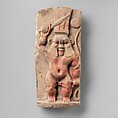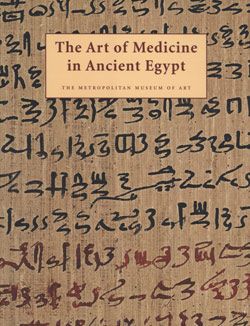Stela of the God Bes
Ptolemaic or Roman Period
Bes waves a knife in one hand and in the other grasps a snake, whose long tail curls up toward a round shape, probably the god's tambourine. A hole remains where a large erect phallus would have been inserted. Considerable traces of paint remain; the characteristic lines on the god's face and curls on his beard may have been added in paint.
A few limestone reliefs and terracottas of this type exist. One in Amsterdam comes from the "Bes Chambers" excavated in the Anubeion at Saqqara. The Bes chambers were decorated with large terracotta wall reliefs of Bes with a large phallus and accompanied by a smaller female figure. They are theorized to have been places where pilgrims came to stay and sleep in order to receive divinely inspired dreams, a practice known as "incubation," propheseying fecundity. This relief could have functioned in such a place, or it could have had the same beneficial effect in a less specialized context.
Due to rights restrictions, this image cannot be enlarged, viewed at full screen, or downloaded.



